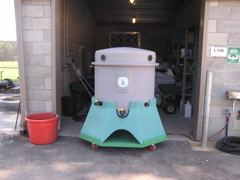Making Activated EM (AEM)
Effective Microorganisms (EM) can be activated so that you end up with approximately 20 times the original amount. This is definitely not necessary, but it is often done to save money. It also helps to awaken dormant microbes. Application rates are the same either way.
Ingredients (per 1L):
1 part EM (40ml) -research shows that up to 1.5 parts may be better; I now use 1.25 parts (50ml)
1 part Organic Blackstrap Molasses (40ml)
20 parts dechlorinated water*, not distilled or reverse osmosis (800ml)
Clean, airtight bottle (1L), generally plastic with screw-on lid (not glass) – can use bigger jugs, too. (do not use a jug in which a bad batch has previously been fermented, unless it has been washed, scrubbed, bleached, and cleaned with EM, and then all of these steps repeated again)
pH paper is very useful to determine if your batch is good
Optional and optimal (I currently sell the last 3 in 1L bottles):
1/4 tsp ceramic powder to structure the water (more won't hurt)
1/2 Tbsp rock dust for minerals
1/2 tsp sea minerals for many good things
1/2 tsp liquid kelp for many good things
1/2 tsp liquid fish for many good things
There are several other ingredients not listed here that I use in my own activations.
*Dechlorinated water is not necessary, but definitely beneficial, as chlorine kills microorganisms. Tap water can be dechlorinated by letting it sit out for 24 hours. If the tap water has chloramine (such as in Victoria), a small amount of humic acids will help to tie it up (1/2 tsp per litre).
Directions:
1. Heat some of the water to 115-125F
2. Pour water into your bottle and dissolve molasses
3. Mix in any of the optional ingredients and then mix in the EM
4. Add the remaining water and stir and/or shake very well.
5. There should be an airspace equivalent to about 10% of the bottle on top
6. Tighten lid and keep warm (95-110F is optimal) for at least 2 weeks, preferably longer**
5. After the first few days, the container needs to be burped every day or two, as gases are formed that will expand the bottle. The mixture should be stirred and/or shaken daily for the first 3 weeks, too.
6. Can be used when pH is below 3.9, but preferably below 3.7. It should also have a sweet smell (it may smell a bit when you initially take off the cap, but if that persists for more than 10 minutes of the cap being off, or if the pH is 3.9 or over, it should not be used; note that if you add fish and/or kelp, it may have a smell to it, but that is okay).
7. Product is better left for at least 4 weeks for highest benefits
**Can be kept warm in an oven with the oven light on (put a note on the oven), in a cooler with a terrarium heater or some other heat source, or many other ways. The whole process can be done at 70F, but it will take 6-8 weeks, and the odds of failure are higher. Even keeping it warm for the first few days is helpful.
Storage:
1. EM Mother Culture stores for 6-24 months, or potentially a few years
2. Activated EM stores for a month or two, or potentially 2 or more years if it is a good batch. Cooler room temperatures will keep it longer (10-20C is optimal). Store it in the dark, with the lid tight.
3. While it is good to brew it with a bit of airspace and stir/shake it daily during the first 3 weeks of brewing, it is best to store it after that without any airspace and without any more shaking if you want to keep it stored for more than a month. The odds are, if you are brewing it for long term storage, you are probably brewing many bottles at once, therefore one of the bottles can be used to top off the rest, and then the remainder in that bottle can be used first.
Note:
Activating EM is not an exact science. As such, the occasional batch may fail to drop in pH to an appropriate level. You may try adding a bit more EM and other optional ingredients, or you may decide to throw it into the compost (or down the drain if it smells bad) and start again. Some of the
most common reasons for failure are:
1. Inappropriate containers (previously containing chemicals, putrefied food, bad AEM batches)
2. Poor water quality (distilled, reverse osmosis, polluted, very high in chlorine)
3. Filling the container too full during initial fermentation stages (best if only 90% full)
4. Not optimal temperature (too hot or too cold)
5. Not burping and stirring/shaking daily
6. Trying to cheat by using more molasses than EM
If you follow the directions above, you will be very likely to produce a beautiful activated EM.
Phil






